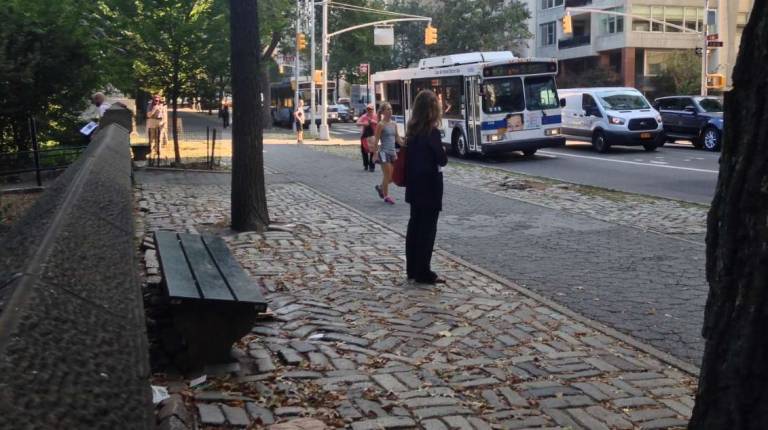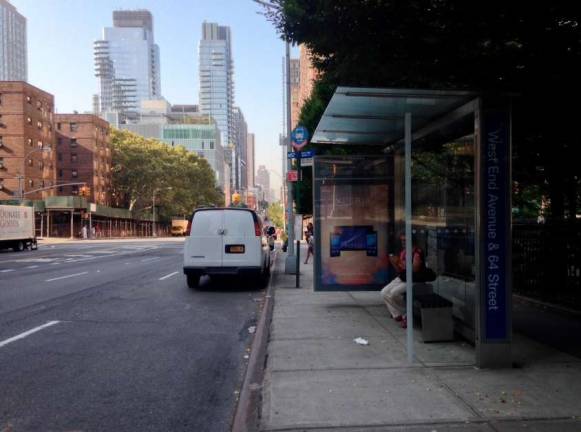A place to sit on fifth Avenue News


Beauty and expediency are skirmishing along Fifth Avenue.
The tussle got a public airing during a Community Board 8 committee hearing last week, following an Upper East Side resident’s suggestion that bus shelters be installed on Fifth Avenue along Central Park.
Betty Cooper Wallerstein, who takes daily bus trips, said Fifth Avenue is among very few major city thoroughfares without the signature rectangular glass and steel shells. She said the shelters are a necessity, particularly since so many bus lines travel along the thoroughfare.
At present, people who travel the avenue by bus have no choice but to stand beside the road to ensure their buses stop to pick them up, she said. And on rainy or snowy days, doing so can be unpleasant at best, particularly for those going home following their workdays at any number of Upper East Side businesses and institutions.
“You can wait a very long time” for buses, said Wallerstein, a former CB8 board member. “There are priorities and I think it’s very important to have the amenities.”
Wallerstein’s suggestion drew opposition, some of it pronounced, from members of the Carnegie Hill Neighbors associaton, who said that the avenue’s charm would be compromised by placement of shelters onto the cobblestone sidewalks.
Lo van der Valk said that although he was “sympathetic” to Wallerstein’s suggestion, it merited careful study, not least since Fifth Avenue is inundated with bus traffic.
“We have to weigh the other aspects of an initiative like this,” he said. “One of the aspects is that Central Park is a jewel and so is Fifth Avenue and what we’ve noticed is that bus shelters often carry with them a lot of lighting and advertising and that’s going to detract from our iconic Fifth Avenue.”
David Stoll was more forthright, calling Wallerstein’s proposal “an awful idea.”
“Aesthetics matter,” he said, calling the park side of Fifth Avenue “special.”
“To clutter it with plastic and metal would be a real shame. We have enough ugliness in the city, we don’t need more,” he said.
Stoll, who lives on Fifth Avenue in the 90s and takes the bus to work, said trees along the sidewalk usually provide sufficient protection from the elements, making the shelters mostly unnecessary.
“We don’t have too many special places in New York that aren’t being overrun with development,” he said. “I just don’t see how this makes any sense.”
Board members who spoke up appeared split on the idea.
One who said she was opposed, Michele Birnbaum, said installation of the shelters would irretrivably compromise the distinctive sidewalks.
“Theres a design to it, there’s a uniformity to it, there’s a history to it,” she said of the walk’s motifs.
She also said the shelters would be redundant given the abundance of benches along Central Park’s outer wall. “You can be seated at that bench and see a coming bus from blocks away,” she said.
A. Scott Falk, though, said that the wide sidewalks — 30 feet — can make it difficult to get from the benches to curbside once a bus comes into view since bus drivers do not typically stop for people seated at the benches. “Part of better bus service is also better amenities for bus riders,” he said. Hedi White said the proposal was at the very least worth exploring.
“I’m a little conflicted when I hear strictly aesthetics superseding the needs of public citizens ... especially those that can’t jump or don’t jump in a cab all the time and have to wait for the bus,” she said.
Without taking official action, committee members collectively agreed to further explore Wallerstein’s suggestion and to seek input and opinion from relevant organizations and agencies.
One that is likely to have significant input is the Central Park Conservancy, which is tasked for maintaining the park’s perimeter.
“It has not been brought to us,” said Elizabeth Kaledin, a conservancy spokeswoman.
“We’re not the decider,” she said, but “we will be asked our opinion.”